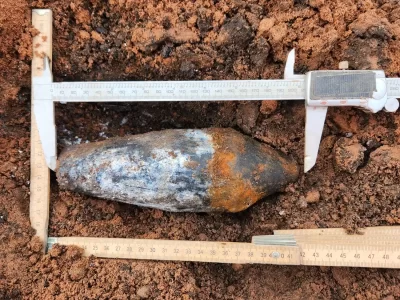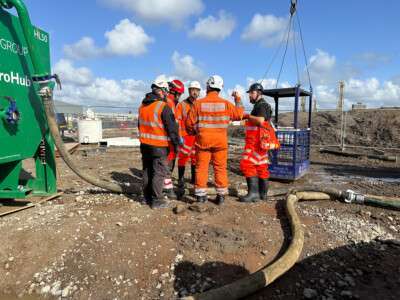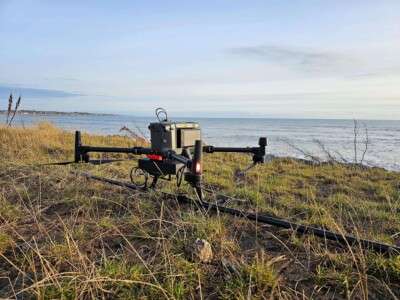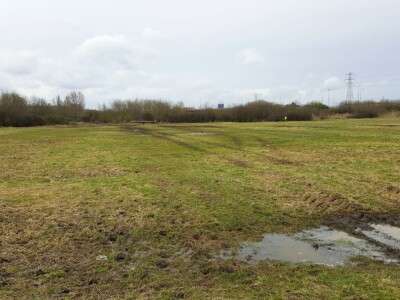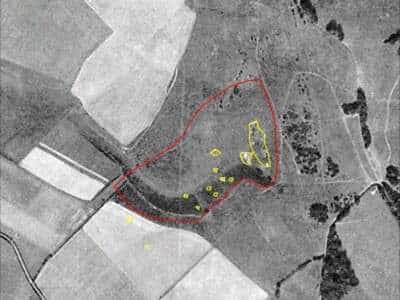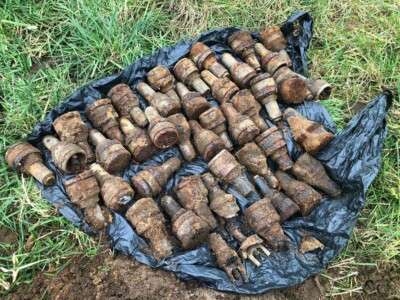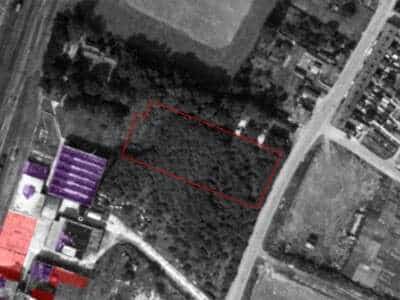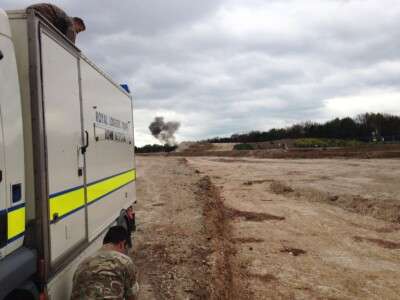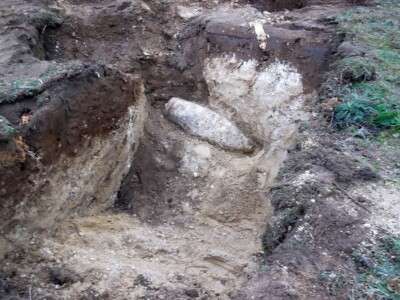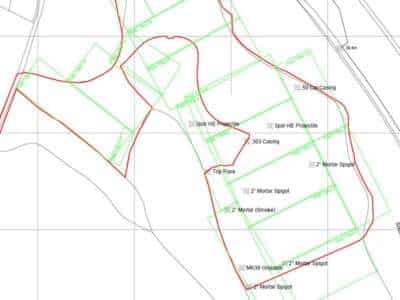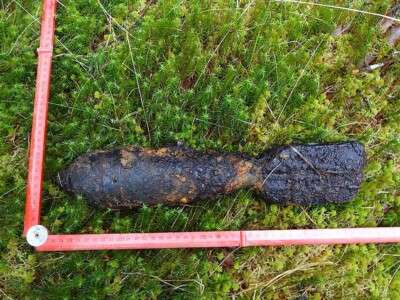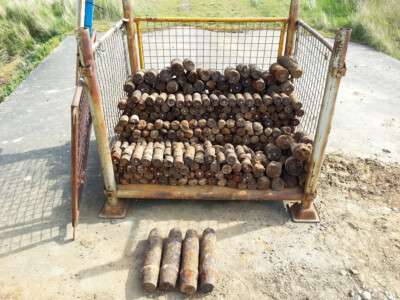Home » Resources » Case Studies »
Case Study Overview
Client Project Category
Ground Remediation
Project Duration
October 2024 – December 2024
UXO Risk
‘Medium-Risk’ of 1kg German Incendiary Bombs
19
1kg Incendiary Bombs recovered
Challenge
In October 2024, 1st Line Defence were approached by our client to provide a UXO Risk Assessment prior to a proposed residential development, near a small village in East Sussex.
Although the village was not near any major WWII Luftwaffe targets or military land, to mitigate any potential risks from UXO contamination, a Detailed UXO Risk Assessment was recommended – plus it was a condition of the Local Planning Authority to investigate the history of the site before any development or groundwork commenced.
Process
Stage 1 – UXO Risk Assessment
The initial findings of the historic research was that the village resided in a rural district that sustained a very low density of bombing during WWII. The district was not a priority target for the Luftwaffe, and although it was subject to ‘tip and run’ and ‘nuisance’ raids – Home Office statistics recorded an average of only eight items of ordnance per 1,000 acres. A bomb map for the county shows the generally sporadic nature of the attacks that the area endured.
Examination of written bomb incident records, obtained from the local archives, indicated that for most of the war – the village escaped any significant Luftwaffe attention. This was not surprising, as aside from a railway station, nothing of interest was observed that may have been viewed as a viable target. The site itself was just an open field, with no buildings or infrastructure present.
However, one surprising reference was found about a relatively large raid across the area early in 1944 – where multiple canisters of incendiary and anti-personnel bombs were reportedly dropped. The records noted exploded and unexploded 1kg Incendiary Bombs (IBs) falling around the station, which bordered the site area to its west – and on a cottage to the immediate south.
This observation was of some concern due to the fact that IB containers could hold anything between 36 and over 600 bombs at any given time.
When deployed, the containers of IBs opened in a ‘shower’ over the target area – the spread of which was determined by the height at which the container opened. Given their small size, if IBs failed to function, they could easily go unnoticed on open/undeveloped land – such as the field where development was now proposed.
Based on the above findings and evidence, the Detailed UXO Risk Assessment concluded that there was a Medium-Risk that the site area could have been contaminated with IBs. 1st Line Defence have worked on several similar sites over the years, where 1kg IBs were reported falling over open, agricultural land during WWII – and unexploded IBs were recovered following a UXO Survey.
Due to this observation, a Non-intrusive UXO Survey of the site was recommended prior to groundworks being undertaken.
See other IB Case Studies below:
What is a 1kg German Incendiary Bomb?
The 1kg IB was one of the most common air-delivered devices dropped by the Luftwaffe during WWII. They were designed to start fires, and were dropped in their thousands over cities and towns across the UK.
Measuring just over 13.5 inches in length (4.74 inches of which was the steel tail section that was riveted to the main body), and two inches in diameter, they were initiated by a small percussion charge in the nose. Filled with thermite and with a magnesium alloy body, they burned at around 2000oC.
1kg B1E, B1EZE, B1EZB Incendiary Bomb
To defeat the efforts of the fire services, a small explosive charge was sometimes used in the tail or nose of the 1kg IBs that was either ignited by the heat itself or by means of a delayed action device.
The bombs were most commonly released from containers which would open, and the IBs would be scattered over the target area.
In the early part of the war, these were usually expendable, aimable types, designated AB (Abwurf Behalter) or BSK (BombenSchaltKasten), holding some 36 B1 El’s. After the container was released, after a short delay, the opening device would function. The two halves of the container would hinge outward, and the bombs inside would fall free.
Stage 2 – Risk Mitigation Strategy
The Detailed UXO Risk Assessment identified a Medium-Risk from German 1kg IBs. While the body and filling of these bombs was respectively magnesium and thermite, they have ferrous content which can be easily detected by magnetometer sensors at relatively shallow depths – and in clean ground.
The site area has remained an undeveloped field since the war, and given the nature of the assessed hazard, the hectarage of the site was calculated – and a quote for the survey team was prepared.
Stage 3 – UXO Survey
The Non-intrusive UXO Survey was undertaken by a two-person ‘walkover’ team in November 2024. The site was relatively small, less than 2ha and the survey was completed in less than a day.
A Magneto MXPDA magnetometer system was utilised for the survey, which comprised an array of fluxgate gradiometers on a metal free/non-magnetic pushcart. The collected data was interpreted using Magneto software, designed to model the mass, depth and location of magnetic anomalies.
Such an anomaly would constitute a local variation in the Earth’s magnetic field caused by man-made ferromagnetic objects or geology, and during data interpretation – a total of 156 anomalies were identified and selected for further investigation.
Stage 4 – Target Investigation
In December 2024, we deployed a two-man explosive ordnance disposal (EOD) and Target Investigation team to investigate the anomalies discovered on the site.
Armed with a GPS system, the team located the position of each anomaly of interest, and undertook excavations to investigate the nature of each target.
Many of the items were identified as agricultural in nature – horseshoes, nails, bolts, bars and brackets. However, what we also recovered were 19 unexploded or partially functioned 1kg German IBs.
The items of live or partially functioning UXO, or those which could not be deemed to be FFE, were separated to be disposed of on-site.
Stage 5 – UXO Disposal
1st Line Defence operatives contacted the police and Ministry of Defence (MoD) to inform them of the discoveries. It was requested by the MoD that the disposal of the items be carried out by a suitably qualified organisation in line with HSE guidance.
The client asked 1st Line Defence to assist with the UXO Disposal operations, and an Explosive Management & Disposal Plan was created for our client.
1st Line Defence destroyed/made safe all UXO-related finds discovered on-site. The risk of UXO contamination was deemed to have been reduced to as low as reasonably practicable (ALARP), and client proceeded with the planned works.
Our client also made sure that a UXO Safety and Awareness Briefing was provided to all ground personnel and machine operators as an additional precaution.
Outcome
Following the findings of the Detailed UXO Risk Assessment, and after the UXO Survey and Target Investigation, the risk from UXO was reduced to ALARP status – no further items of UXO were discovered and the project commenced on schedule.
Click on the following link to download a PDF copy of the Case Study for East Sussex.
Latest Case Studies
Do you have a project in Sussex? Need advice but not sure where to start?
If you need advice about UXO risk mitigation in Sussex, contact us today and we will guide you through the process.
Contact Us
* indicates required fields
